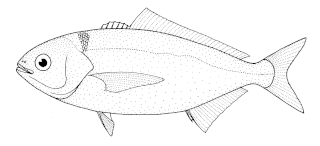
The family Stromateidae or butterfish contains 15 species of ray-finned fish in three genera. Butterfishes live in coastal waters off the Americas, western Africa and in the Indo-Pacific.

Medusafishes are a family, Centrolophidae, of scombriform ray-finned fishes. The family includes about 31 species. They are found in temperate and tropical waters throughout the world.

The white warehou, Seriolella caerulea, is a medusafish of the family Centrolophidae found in the southern Pacific and southern Atlantic oceans, at depths of between 500 and 800 m. Its length is up to about 75 cm.
The silver warehou, Seriolella punctata, is a medusafish of the family Centrolophidae found in the southern Indian and southern Pacific oceans, at depths of between 100 and 650 m. Its length is up to about 65 cm.

The blue warehou or common warehou is a medusafish of the family Centrolophidae found off southern Australia and around New Zealand, at depths of between 5m and 400m. Its length is up to about 75 cm.

The imperial blackfish, Schedophilus ovalis, is a medusafish of the family Centrolophidae found in the eastern Atlantic and the Mediterranean Sea, and occasionally in the western Atlantic (Bermuda). It occurs at depths of between 70 and 700 m. In its juvenile stage, it is often found finding shelter amongst the tentacles of floating jellyfish, including the Portuguese man o' war. It grows to 100 cm (39 in) total length.

The New Zealand ruffe, Schedophilus huttoni, is a medusafish of the family Centrolophidae found in southern Atlantic, Indian, and Pacific Oceans as far north as latitude 18°S, at depths of up to 1,000 m. Its length is up to 90 cm.
The Tasmanian ruffe, Tubbia tasmanica, is a medusafish of the family Centrolophidae, found in temperate waters in the Indian and southwest Pacific Oceans, at depths of between 700 and 850 m. Its length is up to 67 cm.

Hippoglossus is a genus of very large righteye flounders. It comprises two species of halibut, with one species native to the northern Atlantic Ocean and the other species native to the northern Pacific Ocean.

Rastrelliger is a mackerel genus in the family Scombridae. The three species of Rastrelliger together with the four species of Scomber comprise the tribe Scombrini, known as the "true mackerels".

Schedophilus is a genus of ray-finned fish in the family Centrolophidae, the medusafish. The genus has a global distribution.
Nesiarchus nasutus, the Black gemfish, is a species of snake mackerel found in tropical and subtropical waters in most parts of the world, though not in east Pacific and north Indian waters. It occurs at depths of from 200 to 1,200 metres though they make diel vertical migrations from benthopelagic to mesopelagic depths at night. This species can reach a length of 130 centimetres (51 in) SL though most do not exceed 80 centimetres (31 in) SL. It is of minor importance to local commercial fisheries. This species is currently the only known member of its genus, Nesiarchus.

Thyrsitops lepidopoides, the white snake mackerel, is a species of snake mackerel found off the coasts of South America from Brazil on the Atlantic side to Chile on the Pacific side. It can be found at depths of from 30 to 350 metres. This species can reach a length of 40 centimetres (16 in) SL though most do not exceed 25 centimetres (9.8 in) SL. It is of minor importance to local commercial fisheries. It is currently the only known member of its genus.

Solea is a genus of soles from the Indo-Pacific and East Atlantic Oceans, and the Mediterranean Sea.

Pteraclis is a genus of ray-finned fish in the family Bramidae, the pomfrets. They are known commonly as fanfishes. The three species are distributed throughout the oceans of the world.
Neocaristius heemstrai is a species of fish in the family Caristiidae, the manefishes. It is native to the oceans of the southern hemisphere where it is known to occur at depths of from 420 to 1,360 metres. This species grows to a length of 11.8 centimetres (4.6 in) SL.

Icichthys is a genus of medusafishes that are native to the eastern Indian Ocean and the northern Pacific Ocean.

Psenopsis is a genus of medusafishes native to the Indian Ocean and the western Pacific Ocean.

Scombriformes, also known as Pelagia and Pelagiaria, is an order of ray-finned fish within the clade Percomorpha. It contains 287 extant species in 16 families, most of which were previously classified under the suborders Scombroidei and Stromateoidei of the order Perciformes.

Schedophilus medusophagus is a species of ray-finned fish belonging to the family Centrolophidae.















